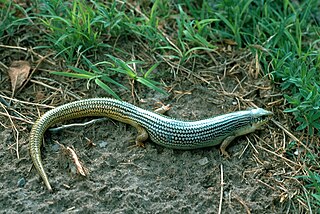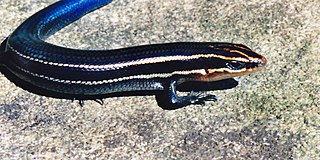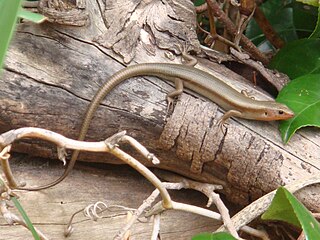
The Florida sand skink is a species of lizard in the family Scincidae, the skinks. It is endemic to Florida in the United States.

Plestiodon egregius, the mole skink, is a species of small lizard endemic to the Southeastern United States.

The western skink is a species of small, smooth-scaled lizard with relatively small limbs. It measures about 100 to 210 mm in total length. It is one of seven species of lizards in Canada. They spend much of their day basking in the sun. Their diet ranges widely, including spiders and beetles. Western skinks will bite if grasped and will flee if they feel threatened. It is a common but secretive species whose range extends from southern British Columbia and throughout Washington, Oregon, Nevada, Utah, Idaho, and Wyoming and into western Montana and northern Arizona and Missouri. They can also live in some areas of Texas It is widespread in northern California but primarily restricted to the coast in central and southern California. Found in a variety of habitats, this lizard is most common in early successional stages or open areas of late successional stages. Heavy brush and densely forested areas are generally avoided. Western skinks are found from sea level to at least 2,130 m (7,000 ft). This diurnal reptile is active during the warm seasons.

Plestiodon anthracinus, the coal skink, is a species of lizard which is endemic to North America.

The broad-headed skink or broadhead skink is species of lizard, endemic to the southeastern United States. The broadhead skink occurs in sympatry with the five-lined skink and Southeastern five-lined skink in forest of the Southeastern United States. All three species are phenotypically similar throughout much of their development and were considered a single species prior to the mid-1930s.

Plestiodon gilberti, commonly known as Gilbert's skink, is a species of heavy-bodied medium-sized lizard in the family Scincidae. The species is endemic to the southwestern United States, and grows to about 7 to 12 cm in total length.

The Great Plains skink is a species of lizard endemic to North America.

The prairie skink is a species of skink endemic to the prairies east of the Rocky Mountains in North America. It is one of only seven species of lizards that occur in Canada.

The (American) five-lined skink is a species of lizard in the family Scincidae. The species is endemic to North America. It is one of the most common lizards in the eastern U.S. and one of the seven native species of lizards in Canada.

Plestiodon inexpectatus, the southeastern five-lined skink is a common skink in the southeastern United States.

The four-lined skink is a species of lizard, which is endemic to North America. It is a medium-sized member of the Plestiodon skinks.

Plestiodon multivirgatus, commonly known as the many-lined skink, the northern many-lined skink, or the variable skink, is a medium-sized species of lizard, a member of the North American skink genus Plestiodon in the family Scincidae.

The northern alligator lizard is a species of medium-sized lizard in the family Anguidae. The species is endemic to the North American west coast.

Plestiodon is a genus of lizards in the family Scincidae (skinks). The genus contains many species formerly classified under the genus Eumeces, except those now placed in Mesoscincus. They are secretive, agile animals with a cylindrical body covered with smooth, shiny scales. They are distributed from East Asia to throughout North America from southern Canada south to Mexico, including oceanic islands such as Bermuda.

Plestiodon barbouri, also known commonly as Barbour's blue-tailed skink and Barbour's eyelid skink, is a species of lizard in the family Scincidae. The species is endemic to Japan.
Plestiodon copei, also known commonly as Cope's skink, is a species of lizard in the family Scincidae. The species is endemic to Mexico.

Plestiodon dicei, or Dice's short-nosed skink, is a species of lizard which is endemic to Mexico. It was named in honor of Lee R. Dice, who collected the holotype in 1930 while conducting a faunal survey in the Sierra de San Carlos, Tamaulipas, Mexico. It was considered a subspecies of Plestiodon brevirostris for many decades. Plestiodon dicei occurs in northeastern Mexico, in the Sierra Madre Oriental in Coahuila, Nuevo Leon, San Luis Potosi, and Tamaulipas, with isolated populations in the Sierra de San Carlos and the Sierra de Tamaulipas.

Plestiodon dugesii, also known commonly as Dugès' skink, Duges's skink, and eslabon in Mexican Spanish, is a species of lizard in the family Scincidae. The species is endemic to Mexico.

The Okada's five-lined skink or Far Eastern skink is a species of lizard which is endemic to Japan.

Plestiodon lynxe, also known commonly as the oak forest skink, is a species of lizard in the family Scincidae. The species is endemic to Mexico. There are three recognized subspecies.





















